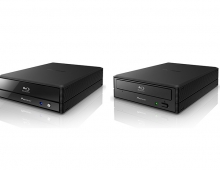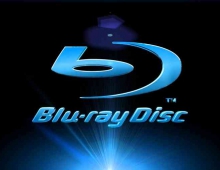
Tough Times Ahead for CD-R/DVD-R Drive and Media Producers
Its not easy being a manufacturer of recordable optical drives and media these days.
Of course, no one ever said that it would be, and the long history of manufacturing various kinds of magnetic recorders and media would tell anyone that bothered to look that this business, whatever the specifics, has always been subject to severe competition, dangerously low margins, and the constant need for investment in new technology and new production equipment in order to remain competitive. The leading manufacturers of CD-R drives and media, for example, have, over the past two or three years, been forced to introduce higher and higher writing speeds at relatively frequent intervals in order to gain breathing room, a bit higher operating margin, and a degree of exclusivity that would distinguish them from their competitors. The same has been true for DVD Write-Once discs, both plus and minus, but with the writing speed increases coming at even shorter intervals than was the case for CD-R.
Unfortunately, any relief that was thus gained was always short-lived, a few months at best. Now, with most CD-R manufacturers offering 48 and 52x writing speeds, this means of keeping ahead of the competition has reached its technological end-point. The same is true for DVD-R/+R; the 16x speed is about the limit in speed-increase for this type of media. This leaves optical disc manufacturers with little other than price to attract buyers, most of which are mostly interested in getting the best price possible. True, the introduction of double-layer DVD+R media (and DVD-R DL late this year) will give leading manufacturers a higher margin product in 2005, but demand is unlikely to be large enough to make much of a difference on anyones bottom line. The only company to date that has DVD+R DL discs on the world market in any volume is Mitsubishi Chemical Media ("Verbatim" in the USA and Europe), with prices in the $10.50 to $15 range per disc, depending on the market.
The next big movement in the optical disc business will be to blue-laser drives and media, but that is at least 18 months in the future. During the interim period, we can expect severe price competition in all forms of CD and DVD drives, and especially in write-once media. Prices are almost certain to be driven down to the absolute minimum possible for survival before the Blu-Laser era begins and offers some relief for leading companies in the field. In fact, there is a sizeable group of manufacturers in Taiwan, often identified as "second tier" producers, that will be caught between the three "big name" producers (CMC, Ritek, and Prodisc), whose reputations and distribution channels will probably sustain them, and the much lower prices offered by Mainland Chinese producers, who are already trying to sell CD-Rs in bulk for less than $0.10 each. This "in-between" group is in very real danger of being pushed out of the optical disc business altogether over the next 12 to 18 months. This is precisely what happened ten years ago when the floppy disk business topped out; prices collapsed and more than 100 diskette fabricators, mostly in China, disappeared within a year.
Several of the Taiwanese producers of optical disc drives have, over the past year, offered their versions of DVD Video Recorders, most often called "DVRs", in an effort to diversify and earn better margins. These recorders generally included a DVD-RW/R combination optical disc drive, but no hard-disk drive. Sales have been, to be polite, "disappointing". The major Taiwanese DVD Write- Once disc producers insisted that, because the price of such recorders would be lower, DVRs without hard-disk drives would become the big sellers, especially in the ultra-price-sensitive American market. This has not proven to be the case. In Japan, which is still the largest market for DVRs, sales in the second quarter of this year were 3.5 times those during 2Q03, and over 70 percent of the recorders sold contained hard-disk drives ("HDDs"). Moreover, those recorders with the highest capacity HDDs (and hence the highest retail prices) actually sold the best. Of course, the Athens Olympics accounts for some of this sharp increase, and the Japanese market is not necessarily the "typical" market for video recorders. Even so, it seems very likely that in both the U.S. and European markets, DVRs equipped with high-capacity HDDs will enjoy the largest sales.
This has forced the Taiwanese DVR producers to develop and bring to market their own HDD-equipped recorders, and the first units are just now beginning to become available. These units will most often include an 80GB HDD, which in todays world market, is a relatively low capacity for this kind of recorder. MMIS suspects therefore that the Taiwanese DVR producers will be disappointed again, and will have to offer units with much higher capacity HDDs if they expect to compete with Korean and Japanese producers and gain much of a market share.
Studies of owners of HDD-equipped DVRs have shown that most of the recordings made on these machines make use of the HDD rather than the optical disc drive. This is increasingly so as the capacity of the HDD increases. Only when there is a need to keep a particular recording is it transferred to a DVD Write-Once disc. For owners of DVRs with HDD capacities of less than 80GB, the ratio of transferred to originally recorded selections is about 20 percent, that is, one in every five recordings initially made on the HDD is transferred to an optical disc in order to prevent the program from being erased. For DVRs with 250GB or higher capacities, this ratio falls to just five percent! While there is too little experience yet to know what the real usage of optical discs with DVRs will be in the future, the available data suggest that this application may not be the bonanza for optical disc media sales that the Taiwanese media producers have insisted it would be!
In 2003, worldwide sales of DVRs, both with and without hard-disk drives, reached 3.83 million units. Early in 2003, Matsushita, the largest DVR producer at the time, suggested that worldwide demand in 2004 could reach 13 million machines. Later, however, when it became apparent that 2003 shipments would not reach its original estimate of 4.4 million recorders for that year, the company revised its 2004 estimate downward to 8.5 million. Now, strong demand during the first seven months of 2004 has caused forecasters to revise full-year shipments upward, and some are again suggesting shipments could be as high as 13 million machines this year. If so, the acceleration in demand seen in the second quarter will have to double during the final five months of the year. This seems unlikely to happen, and leads MMIS to suggest that shipments are most likely to fall between 10.5-11.5 million units.
The Japanese domestic market in 2003 accounted for 2.17 million DVRs, or 56 percent of the world total. Matsushita was by far the largest producer, with a 35 percent share, followed by Sony with 22 percent, Toshiba with 16 percent, and Pioneer with almost 15 percent. For 2004, assuming that sales over the final five months of the year meet the MMIS revised estimates discussed above, the overall picture will look quite different. The Japanese market will account for 4.5-5.0 million recorders, North America for 2.0-2.5 million, Europe for 2.25- 2.75 million, and the rest of the world for about one million units. About ten percent of the recorders shipped will be made by non-Japanese companies. Matsushita will have lost market share, and Sony will have gained.
If we assign an average ex-factory price of $250 for each DVR shipped in 2004, factory revenues would be between $2.75 and $3.0 billion. At retail, their value would be close to $4.5 billion. Not bad for a relatively new product! But the big question remains, how much of a demand will these recorders create for recordable and rewritable optical disc media? This question cannot be answered adequately for another year or more.
Whatever the demand created for recordable optical discs by the DVD, one thing is certain: the advent of modestly priced DVD-R/+R discs, and to a lesser degree rewritable DVD media, has severely impacted the demand for VHS video tape. As recently as the end of 2001, VHS tape accounted for well over 90 percent of the total recordable media units used to make video recordings. VHS tape was used universally in the home to record TV programs, and for the production, both legitimate and pirate, of VHS video software. In 2001, a total of 1,140 million VHS T-120 equivalents were used for the duplication of video programming, and another 1,282 million equivalents were sold in the form of blank VHS cassettes. These are "equivalents", and in terms of pieces duplicated, the 1,140 million equivalents translates to about 1,370 million actual cassettes duplicated.
The figures for 2003, compared to 2001, show a decline in VHS duplicator tape shipments of 56 percent, enough tape to produce just 779 million duplicated software programs. Blank video cassette shipments declined by 17 percent, to just over 1,000 million T-120 equivalents. In 2001, the number of recordable DVD-type optical discs of any type sold was so small that they were insignificant in the overall recordable video media business. This has changed dramatically over the following three years. By the end of 2004, MMIS analysts expect VHS tape will account for only about 45 percent of the recording media used for copying or duplicating video software, and the total number of recordable optical discs used will exceed the total number of tape-based duplicates made for the first time. By the end of 2005, optical discs are expected to account for close to 70 percent of all recordable media used to produce video recordings, legitimate and pirate together. Couple this with the equally rapid increase in replicated DVD-Video programming, and it is clear that VHS tape has already been reduced to a small percentage of the total video software business. And this shift has happened, at least by historical standards, breathtakingly fast!
Perhaps this should not surprise us, given the rapid growth since its introduction in 1997 of replicated DVD-Video software However, the rapid increases in demand for DVD write-once media, is surprising, at least to most analysts, until one understands where most of these discs are being used. The main reason for the extremely rapid increase in recordable optical disc utilization lies in their burgeoning use in producing pirated video programming, especially in Asia but certainly not an uncommon occurrence most everywhere else in the world. Anyone desiring to do so can, for a very small investment, begin turning out excellent quality copies of popular DVD-Video discs using low-cost DVD-/+R media, and if the person or the group making the copies knows how (or where) to sell their output, the profit margins can be very good indeed!
The graph below compares estimates for total video software production, both legitimate and pirated, and both DVD-Video and VHS, with expected production of recordable/rewritable blank DVD optical discs and blank T-120 cassette equivalents, for the years 2004, 2005, and 2006. Since demand for recordable DVD media for legitimate applications (use with DVRs, use on PCs, etc.) cannot possibly account for the rapid growth in demand predicted for them, the only explanation is that the pirate-duplication of video software is shifting rapidly from VHS tape to optical disc. Please note that the data, with the exception of the estimates for blank VHS cassettes, are in "pieces", that is, individual tapes or discs produced. The blank cassette data are in T-120 (two-hour) equivalents.
How and Why the Recorded Music Industry Will Change over the Next Several Years
The LP record ushered in the era of "high fidelity music" in the late 1940s, followed by the CD in 1982. The venerable CD, loved by most of the record-buying public but still, after more than 20 years, condemned by audiophiles as "a step backward in the purveyance of high-fidelity music", has endured some rather significant declines in demand since 2000, due to a variety of reasons, but mostly to shifting interests on the part of most younger record buyers.
True audiophile recordings, in the form of SACD and DVD-Audio pressings, have failed, at least to date, to arouse much enthusiasm from anyone anywhere. According to the latest data, as of August 20 2004, there were only 324 titles available in the DVD-Audio format, and 1,314 titles in SACD. One would think that the audiophile segment of the music-buying public would have welcomed these improved digital formats with open arms, but they have not. Although the music industry insists it is spending more time and money on promoting these two beleaguered formats, there is growing feeling in the industry that they will never gain general acceptance, and will probably disappear altogether from the marketplace over the next three or four years. This belief continues even now that the five major recorded music labels have all agreed to introduce "DualDiscs", in which a specific album is reproduced in standard CD on one side of the disc, and in DVD-Audio on the other.
A large percentage of all CD-listening today is done using portable players and earphones, and the quality of sound reproduction is anything but "high fidelity". Moreover, in America alone, there are now more than 20 online services, similar to Apples "iTunes", that offer recorded music for purchase and downloading, and millions of tunes are still being downloaded illegally each day over peer-to-peer Internet connections. Most of this music will be heard either on a PC or a portable device (with earphones), and again, the quality of the music reproduced could never be called "high fidelity".
The key point to be made here is that most of the people listening to recorded music today, whether at home, in a car, or from portables on earphones, find the quality of sound provided completely adequate for their purpose. They are not particularly interested in "high fidelity", and most definitely are unwilling to pay a premium for it. Convenience and versatility are much more important to these record buyers than sound-fidelity, a fact that is already having a strong effect on the audio side of the consumer electronics business, and eventually could eliminate the use of physical recordings (like CDs) altogether. Why buy CD albums for $15.99 when you can download the specific tune you want for ninety-nine cents (or less!), and are perfectly happy to listen to that tune using earphones connected to a flash-memory player?
Two elements of the music business do retain a demand of sorts for higher fidelity music recordings. The first of these is the "Home-Theatre" phenomenon. The impetus here of course is to provide as close as possible an equivalent in the home to the visual and audio experiences presented in a motion-picture theatre. A surprisingly large percentage of homes in the U.S., and indeed a growing number elsewhere, have "home theatre" installations that have cost anywhere from $5000 to $500,000 to install! And the quality of sound that most of these installations provide is often impressive indeed! However, this is, like the "high-fidelity" craze of the 1960s and 1970s, a highly limited market, especially when compared with portable audio, MP3 and iTune players.
The second type of higher fidelity music is what is usually called "Music Video". This is just what it says it is: a video recording of a musical group. Music video has been around for years, but never really caught the publics eye. Philips tried valiantly to introduce a version of the CD that offered a video presentation of the lead tune, and then audio only. It went nowhere. VHS music videos generated some business, but never advanced into a broadly accepted format. It is only in the past two or three years that DVD Music Videos have gained a following, and that following appears to be significant and growing in every major music market in the world today. Japan has been the most active market to date, but demand in the U.S. is growing rapidly, and it is beginning to stir in places like the UK and France. Apparently buyers want to see as well as hear the performers! In fact, in Japan, they want to watch music videos on their mobile telephones and on their iPod players, and the providers of music video software and appropriate hardware are rushing new products into production to accommodate them!
This all suggests to MMIS analysts that major changes are underway in the recorded music industry. This is hardly an unusual or exclusive viewpoint; indeed, it has been obvious for some time now that technology is forcing changes that are anything but welcome to the established recorded music industry. That industry is expected to enjoy higher unit sales and revenues in 2004 than it has achieved over the past three years; the BPI in the UK, for example, has just reported that second quarter CD sales were up 4.1 percent, and CD revenues 3.5 percent, compared with the same period a year ago. These improved results are expected to be repeated, given a percentage point or so, in the U.S., Canadian, and Japanese recorded music markets. However, we think any increase is temporary, and that the trend in CD demand will be one of general steady decline. The genie is out of the bottle. The recorded music industry is already in the early stages of a revolution that, over the next ten years, will alter it beyond recognition, and eliminate most of the current structure now used to purvey recorded music.
The Next Generation of Super-Tape Cartridges Is Being Readied for Market
"Super-tape cartridges", for our purposes here, include DAT-72, S-DLT, LTO-Ultrium, AIT, and SAIT formats. These cartridges and cassettes are used principally in middle-level and enterprise-level data-storage applications, where high reliability and high capacity are required. All DAT-DDS formats use an advanced metal-pigment tape 3.81mm wide, and are housed in a cassette rather than a cartridge, as are the AIT products, which utilize thin-film cobalt-metal tapes of 8mm width. All the other formats are housed in what is known as the standard IBM single-reel cartridge, and use tape 12.65mm in width.
DAT-72, which was introduced commercially in early 2003, has gained some popularity, especially now that the average price per cassette has fallen well below $20. There is talk already of a still-higher capacity DAT-DDS drive and cassette, with HP the driving force behind this. As in other tape and optical disc formats, it is necessary to introduce new "generations" of media at regular intervals of 18-24 months if one expects the format to maintain its position in the overall data-storage business. Presumably, a new generation of the popular DAT-DDS format, which is widely used for backup purposes in many offices and homes, would provide double (or nearly double) the capacity of the DAT-72 cassette, which is 36GB native. Nothing formal has been announced by HP or any other company involved in DAT-DDS drive and media production, but the rumors are flying, and HP is definitely seeking support for Gen-6 of the DAT-DDS format!.
There is no rumor about the next generation of LTO-Ultrium half-inch cartridges. LTO drives and cartridges account for about two-thirds of all data-tape storage products sold in middle and enterprise level applications. In late July, formal announcements were made by the LTO Consortium regarding Ultrium-III, which will double cartridge capacity to 400GB native (800GB compressed). Imation was the first company to announce publicly that it had submitted samples of Gen-3 media for testing and approval. The tape used in this new cartridge, according to Imation, will be the first based on what the company calls its "Tera-Angstrom" technology, presumably similar in concept to what Fujifilm calls its "NanoCubic" line of data-tape and video products. NanoCubic tape is already in use commercially, in the form of IBMs 3592 300GB enterprise-level cartridges.
Presumably, there will also be announcements soon on Gen-3 products from Quantum Corporation, the main producer of Super-DLT drives, and from the companies that produce the cartridges used in them. S-DLT Generation II cartridges have a native capacity of 300GB, and Gen-3 would double this. Sony, the sole producer of AIT drives and cassettes, began sale of its fourth generation AIT product line at the end of July. AIT-4 cassettes provide 200GB native capacity.
Two of the leading producers of data-tape products, Hitachi Maxell and TDK, both announced significant declines in the profitability of their "information-storage" products for the second quarter of 2004. Maxell saw a decline of only 2.3 percent in unit sales, but a 43.5 percent decline in the operating income derived from these products, compared with the second quarter of 2003. Competition is just as fierce in the data-tape business as it is in optical disc media, with six major companies competing for a share of what is a relatively small total business. In 2004, the total data-tape business is expected by MMIS to generate revenues of about $1.5 billion.
Magnetic tape remains the most broadly used medium for the back up and archiving of data. This is largely due to its low cost per gigabyte stored. Most large users of data-tape products would like to lessen their dependence on tape, which is increasingly unable to meet their needs. To this end, there is a growing movement to back up data first to hard-disk drives, since drive capacities are now large enough to make this effective, and backed-up data that is frequently needed can be accessed almost instantaneously. That part of the backed up data that is less frequently needed is then transferred to data-tape cartridges. To protect a companys stored data, archived files are duplicated and the duplicate set stored off-site. It is a complex and costly operation, but a very necessary one, and one in which magnetic tape products will continue to play a vital role for sometime to come.
From MMIS





















